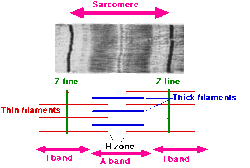
Back ساركومير Arabic সারকোমিয়ার Bengali/Bangla Sarkomera BS Sarcòmer Catalan سارکۆمێر CKB Sarkomera Czech Sarkomer German Sarcómero Spanish Sarkomeer Estonian Sarkomero Basque
| Sarcomere | |
|---|---|
 Image of sarcomere | |
| Details | |
| Part of | Striated muscle |
| Identifiers | |
| Latin | sarcomerum |
| MeSH | D012518 |
| TH | H2.00.05.0.00008 |
| FMA | 67895 |
| Anatomical terms of microanatomy | |
A sarcomere (Greek σάρξ sarx "flesh", μέρος meros "part") is the smallest functional unit of striated muscle tissue.[1] It is the repeating unit between two Z-lines. Skeletal muscles are composed of tubular muscle cells (called muscle fibers or myofibers) which are formed during embryonic myogenesis. Muscle fibers contain numerous tubular myofibrils. Myofibrils are composed of repeating sections of sarcomeres, which appear under the microscope as alternating dark and light bands. Sarcomeres are composed of long, fibrous proteins as filaments that slide past each other when a muscle contracts or relaxes. The costamere is a different component that connects the sarcomere to the sarcolemma.
Two of the important proteins are myosin, which forms the thick filament, and actin, which forms the thin filament. Myosin has a long, fibrous tail and a globular head, which binds to actin. The myosin head also binds to ATP, which is the source of energy for muscle movement. Myosin can only bind to actin when the binding sites on actin are exposed by calcium ions.
Actin molecules are bound to the Z-line, which forms the borders of the sarcomere. Other bands appear when the sarcomere is relaxed.[2]
The myofibrils of smooth muscle cells are not arranged into sarcomeres.
- ^ Biga, Lindsay M.; Dawson, Sierra; Harwell, Amy (2019). "10.2 Skeletal Muscle". Anatomy & Physiology. OpenStax/Oregon State University. Retrieved 22 May 2021.
- ^ Reece, Jane; Campbell, Neil (2002). Biology. San Francisco: Benjamin Cummings. ISBN 0-8053-6624-5.
© MMXXIII Rich X Search. We shall prevail. All rights reserved. Rich X Search